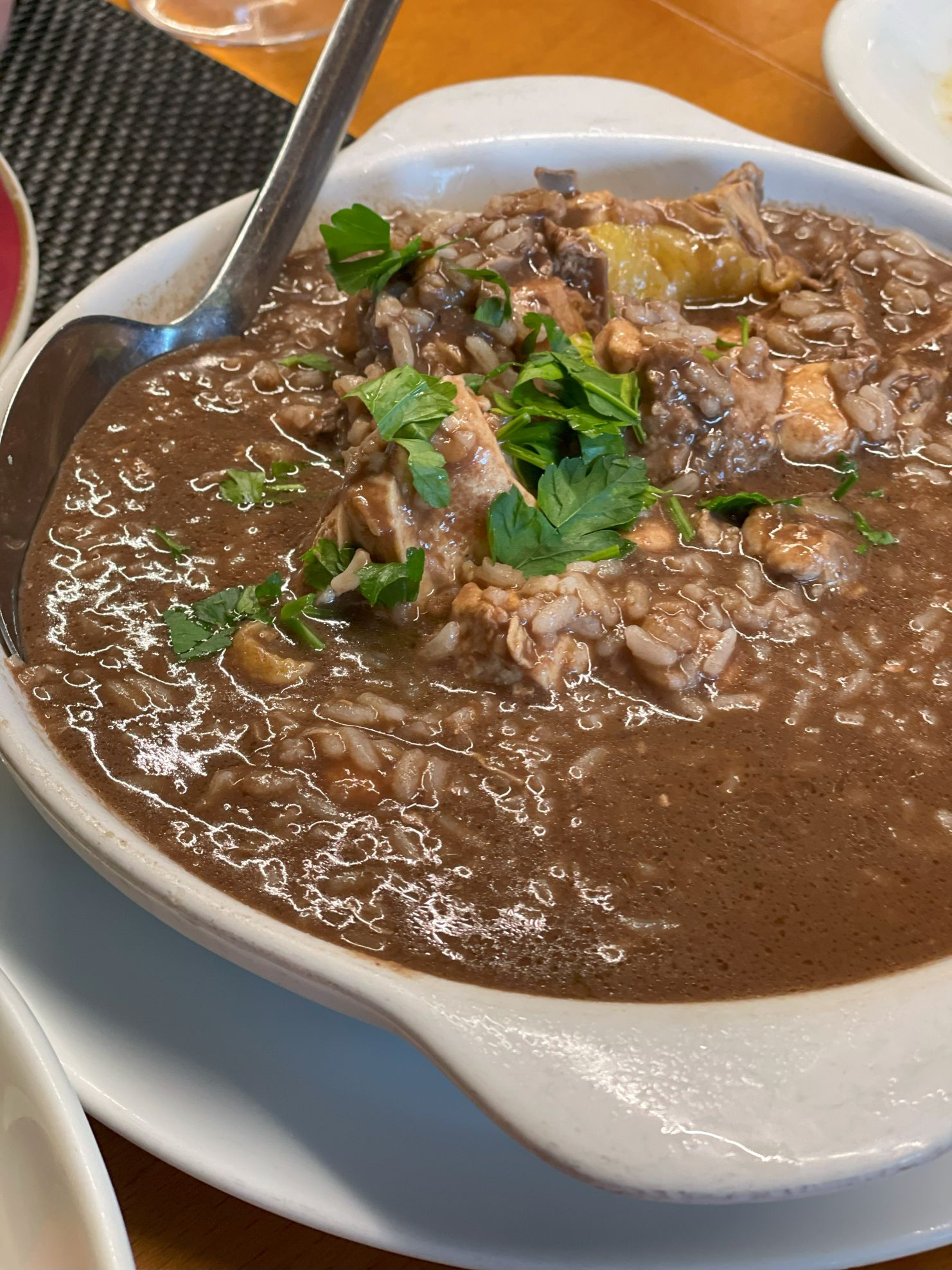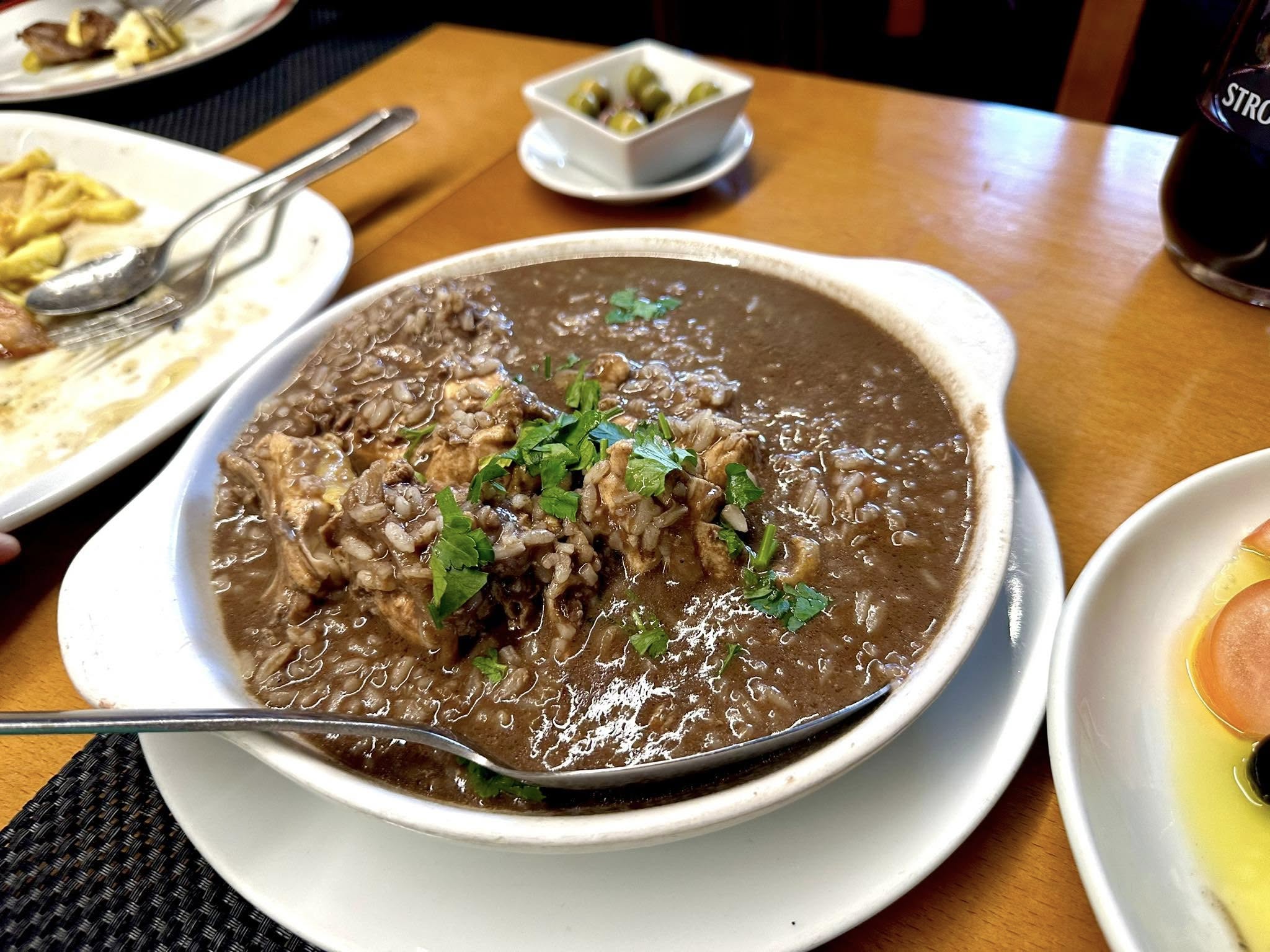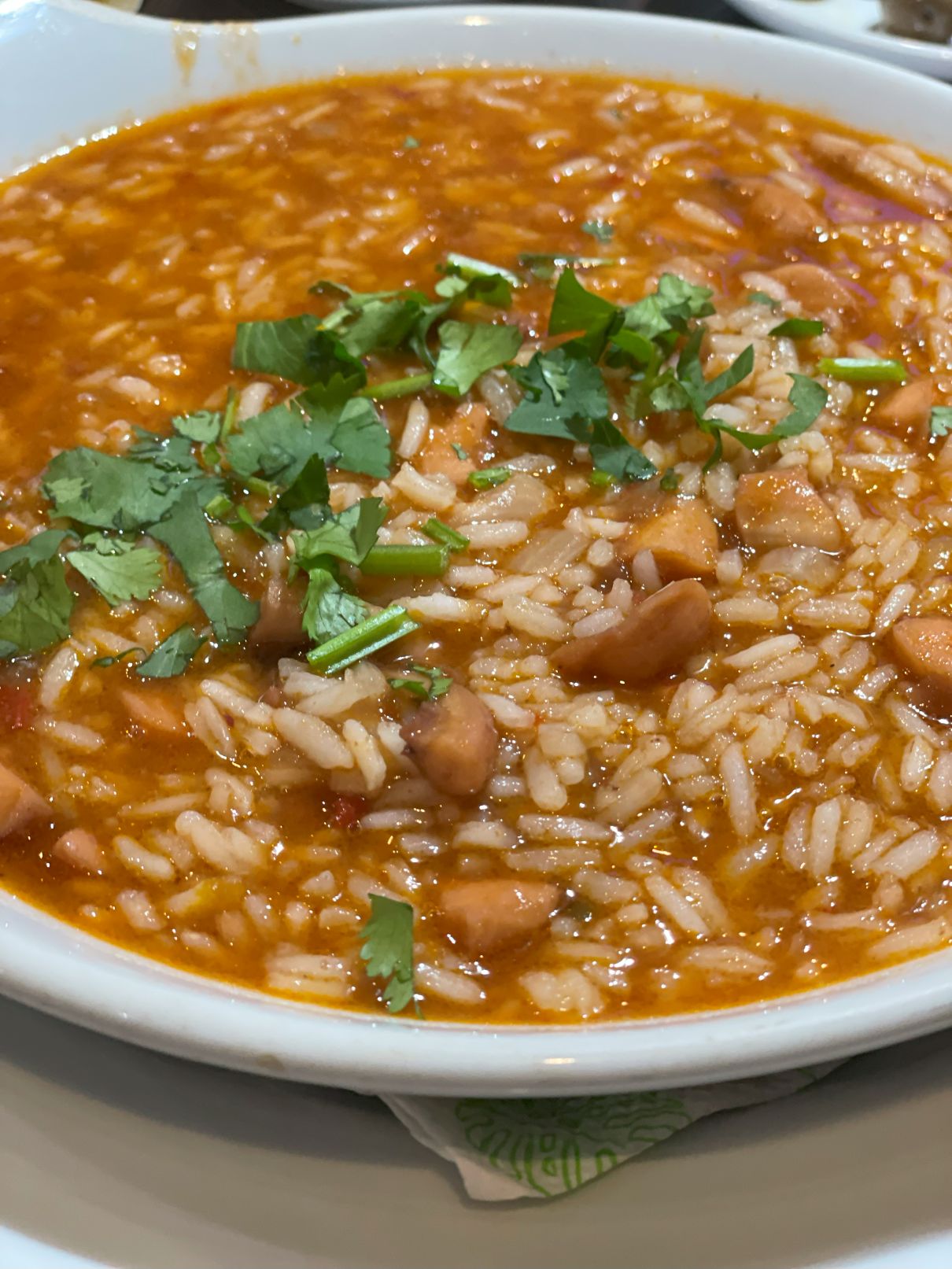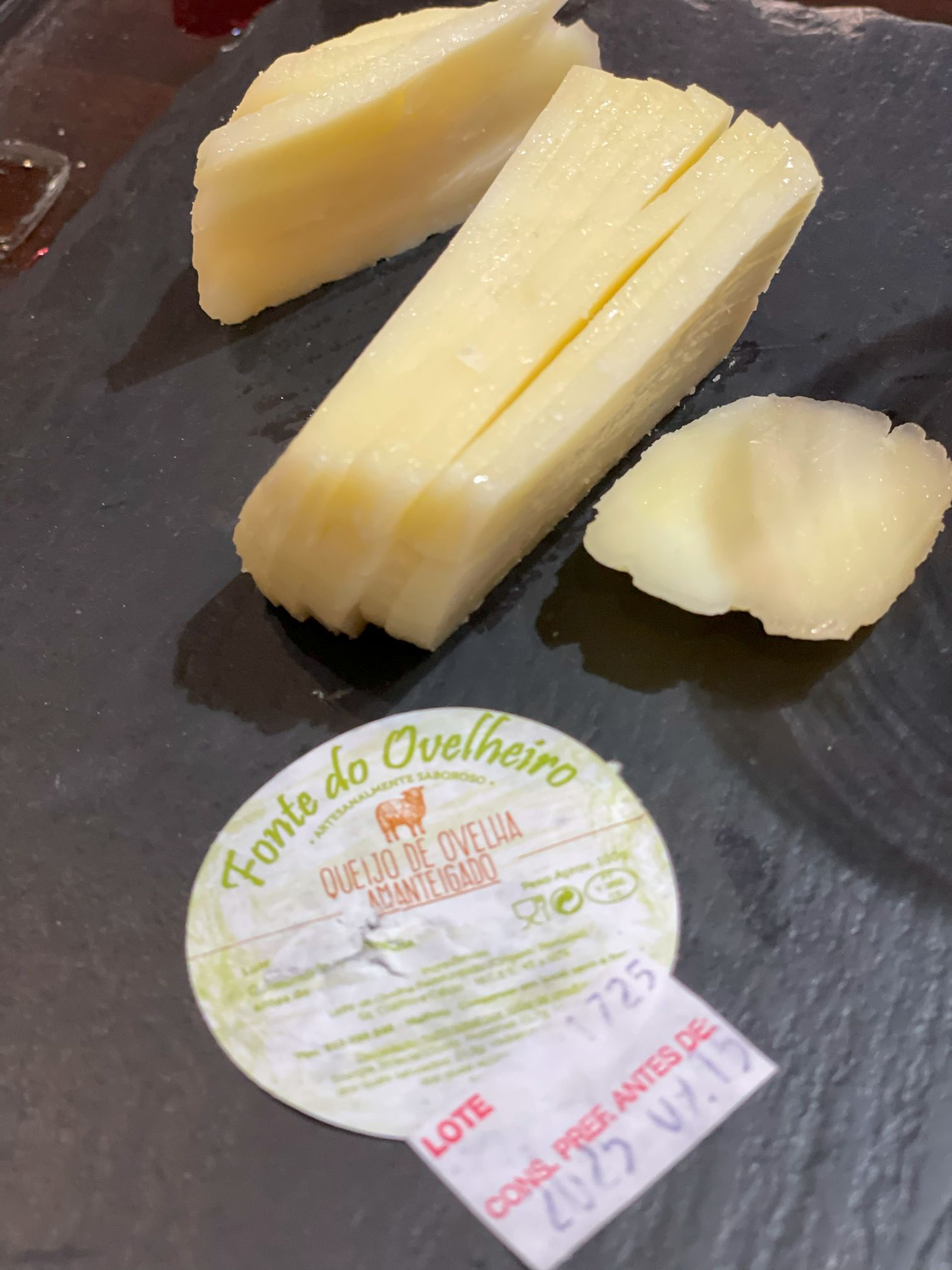どうしてもタラ料理に注目が集まりがちなポルトガルですが、実は「お米料理の宝庫」であることはあまり知られていないかもしれません。地域ごとに特色あるレシピが存在し、例えば『Arroz de Tamboril(アロス・タンボリル/あんこうご飯)』や『Arroz de Pato(アロス・デ・パト/鴨ご飯、グリル仕上げ)』など、実にバラエティ豊かです。
その中でも、もっともポルトガルらしい味わいで、世界的にも知られているのが『Arroz de Cabidela(アロス・カビデラ)』だと思います。昔は鶏を食べるとき、家で飼っていた鳥をしめて調理するのが習慣で、その際に血も大切に利用されました。このご飯料理の最大の特徴は、まさにその鶏の血を加えていることです。見た目はチョコレートソースのような色合いですが、これは血によるもの。材料を先に伝えると敬遠されがちなので、必ず「ポルトガルを代表する伝統料理です」とPRしてから注文します。
*因みにこの料理、インターナショナルなお米料理コンクールで、ナンバーワンに選ばれた事もあるくらい優れた料理なのです。


この日は食いしん坊の従妹一家と旅をしており、偶然入ったローカルレストランで黒板に「本日のメニュー」として書かれていたのを発見。ぜひ食べてもらいたくて、飲み物より先にオーダーしました。幸運なことに残り一人前だけあり、みんなでシェアして味わいました。幸い、誰も食材を聞いて嫌がるタイプではなかったので、大喜びで楽しんでくれました。
鶏の血はそのままでは固まってしまうため、調理にはワインビネガーが欠かせません。さらにスパイスも重要で、大航海時代にポルトガルが独占していたクローブが使われています。古いレシピにはサフランも登場し、この料理がごちそうとして振る舞われていたことが分かります。
従妹とは他のお米料理を楽しむ時間がなかったのですが、私はスペインへ戻る途中、リバテホ地方で『Arroz de Polvo(アロス・デ・ポルヴォ/タコご飯)』をいただきました。

訪れたのはゴシック建築で知られる町サンタレン。町のショップの方に教えてもらった老舗食堂で、なんと1856年創業とのこと。お店のマークもリバテホの民族衣装をまとった人物がモチーフで、とても愛らしいものでした。

食後にはデザートとして地元のチーズも楽しみましたが、ラベル付きでサーブしてくれるので気に入った時にメーカーを探すことができ、本当にありがたいサービスだと思いました。やっぱりチーズはアレンテージョの羊乳が美味しいなぁと感じながら、スペインへの帰途につきました。

English Version
In Portugal, codfish dishes often take the spotlight, but the country is also a true treasure trove of rice recipes—a fact not as widely known. Each region has its own specialties: Arroz de Tamboril (monkfish rice), Arroz de Pato (duck rice, finished in the oven), and many others.
Among them, the one that feels most authentically Portuguese and is internationally renowned is Arroz de Cabidela. Traditionally, when families prepared chicken, it was common to slaughter a bird at home, and nothing was wasted—the blood was also used. The hallmark of this dish is precisely the addition of chicken blood, which gives it its distinctive dark color, almost like chocolate sauce. Since the mention of blood can discourage some diners, I always present it first as one of Portugal’s most iconic traditional dishes.
I first shared it with my cousin’s family, true food lovers, during a trip through Portugal. In a small local restaurant, we spotted it written on the chalkboard as part of the weekend menu. I ordered it immediately—before drinks even arrived—because I wanted them to try it. Luckily, there was just one portion left, and we shared it among all of us. No one in the group was the type to be put off by the ingredients, so it was a joyful discovery.
Chicken blood coagulates if not treated properly, so wine vinegar is an essential ingredient. Spices also play a key role, notably cloves, once monopolized by Portugal during the Age of Discovery. Some old recipes even included saffron, showing that this dish was once considered a true delicacy. This dish has even won first prize in an international rice competition, a testament to its excellence.
Later, although I didn’t have the chance to try more rice dishes with my cousin, I enjoyed Arroz de Polvo (octopus rice) while passing through the Ribatejo region on my way back to Spain.
The town I visited was Santarém, famous for its Gothic architecture. I went to a traditional eatery recommended by a local shopkeeper—astonishingly, it has been in operation since 1856. Its logo features a figure in traditional Ribatejo dress, which I found charming. For dessert, I savored local cheeses, thoughtfully served with their labels so you can find the producers later if you wish. I couldn’t help but think once again that sheep’s milk cheese from Alentejo is truly among the finest, as I made my way back toward Spain.
Versión en Español
En Portugal, los platos de bacalao suelen llevarse toda la atención, pero lo cierto es que el país es también un auténtico tesoro de recetas de arroz, aunque no todo el mundo lo sepa. Cada región cuenta con sus especialidades: Arroz de Tamboril (arroz con rape), Arroz de Pato (arroz de pato terminado al horno), entre muchas otras.
Entre todas ellas, quizás la más portuguesa y reconocida internacionalmente sea el Arroz de Cabidela. Antiguamente, cuando se comía pollo, era costumbre sacrificar un ave en casa, y nada se desperdiciaba: también se utilizaba la sangre. La característica principal de este plato es precisamente esa, el uso de la sangre del ave, que le da su color oscuro, casi como una salsa de chocolate. Como puede impresionar a algunos comensales, siempre lo presento primero como uno de los platos tradicionales más representativos de Portugal.
Lo probé por primera vez con la familia de mi prima, grandes aficionados a la buena mesa, durante un viaje por Portugal. Entramos por casualidad en un restaurante local y lo vimos escrito en la pizarra del menú de fin de semana. No dudé en pedirlo incluso antes de las bebidas, porque quería que lo probaran. Tuvimos suerte: quedaba solo una ración y la compartimos entre todos. Nadie en el grupo se echó atrás al conocer los ingredientes, al contrario, lo disfrutamos muchísimo.
La sangre de pollo, si no se trata adecuadamente, tiende a coagularse; por eso, el vinagre de vino es un ingrediente fundamental. Las especias también son esenciales, en particular el clavo, que Portugal monopolizó durante la época de los descubrimientos. Algunas recetas antiguas incluso incluían azafrán, lo que demuestra que este plato era considerado un auténtico manjar. Este plato ha llegado a ganar el primer premio en un concurso internacional de arroces, lo que dice mucho de su calidad.
Más tarde, aunque no tuve oportunidad de probar otros arroces con mi prima, sí pude disfrutar de un Arroz de Polvo (arroz con pulpo) en la región del Ribatejo, de camino de regreso a España. Este plato ha llegado a ganar el primer premio en un concurso internacional de arroces, lo que dice mucho de su calidad.
La ciudad que visité fue Santarém, famosa por su arquitectura gótica. Allí, gracias a la recomendación de una tienda local, descubrí una casa de comidas tradicional que funciona nada menos que desde 1856. Su logotipo muestra a una figura con el traje típico del Ribatejo, un detalle encantador. De postre, disfruté de quesos locales, servidos con sus etiquetas, algo que agradezco porque permite identificar al productor si el queso te gusta. Y mientras regresaba a España, pensaba que, sin duda, los quesos de oveja del Alentejo están entre los más sabrosos que he probado.


コメント